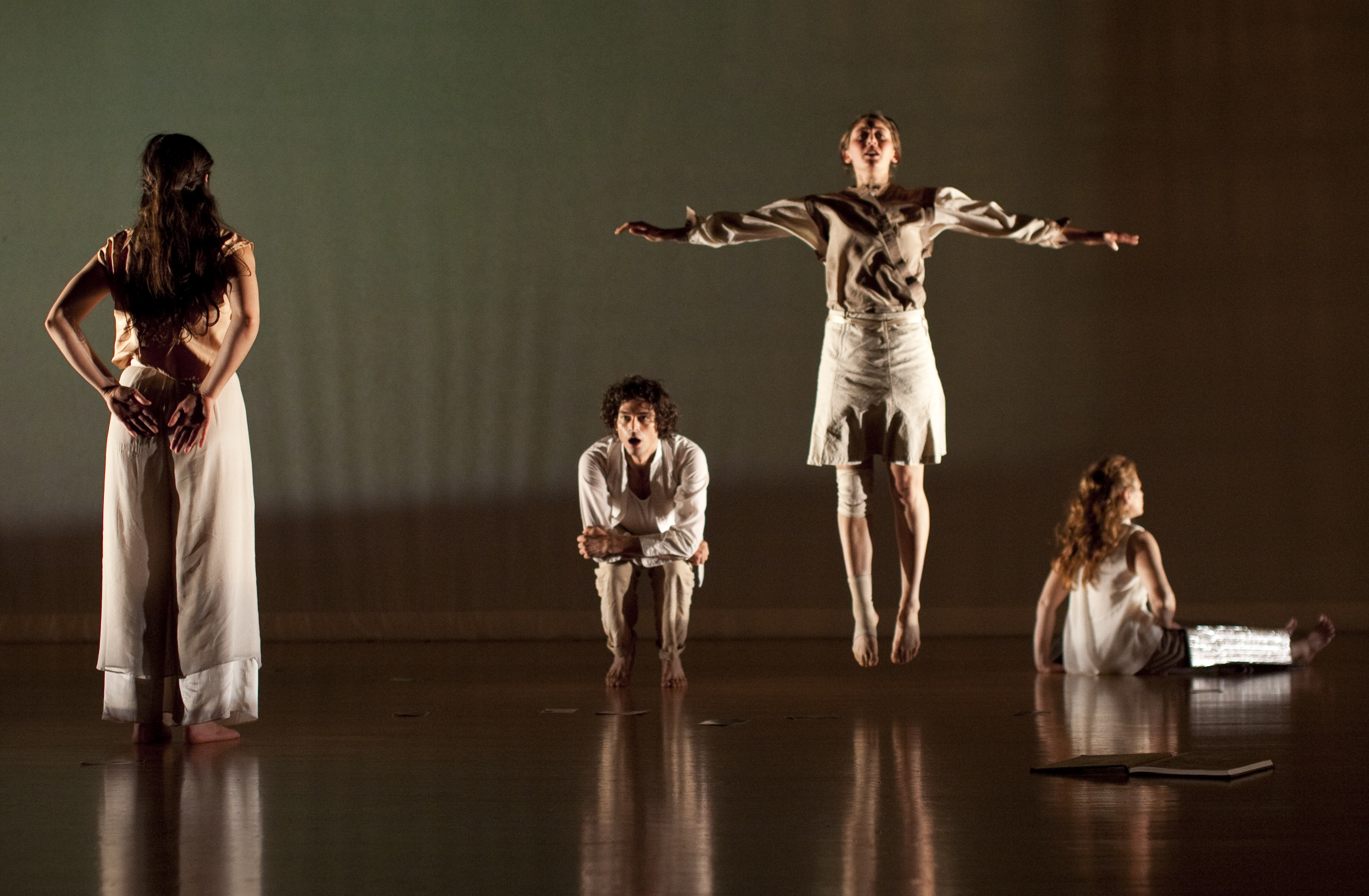Grad students translate abstract into visual through choreography in ‘Exit Strategies’

“Exit Strategies” is a joint production featuring the final projects of two third-year graduate dance students, Carson Efird and Alexandra Shilling, who use their choreography as a mode of translating emotions and abstract concepts such as memory and loss into a visual experience. Their work will be showcased today and Friday.
"Exit Strategies"
Today-Friday, 8 p.m.Kaufman 200, $8 for students
By KELLYANNE TANG
April 25, 2013 12:00 a.m.
The stage was set for the final run-through, with old photographs laid out neatly in the spotlight and the whisper of a Super 8 projector in the background. With a vintage film clip playing on the backdrop, the dancers prepared to tell the story of the choreographer, one of two graduate students who are showcasing their work this week.
Tonight, third-year graduate dance students Carson Efird and Alexandra Shilling will debut “Exit Strategies,” a joint production featuring each of their final projects as graduate students at UCLA. Both students use their choreography as a mode of translating emotions and abstract concepts such as memory and loss into a visual experience.
Shilling, who owned a dance company in New York for five years, said producing a dance concert is nothing new for her. However, she said preparing for this concert has given her the opportunity to explore memory, a theme that has been on her mind for a long time because of her family’s experiences during World War II.
“It’s part of what I came to graduate school to work on,” Shilling said. “My grandparents were Holocaust survivors and I’ve been trying to understand something about how memory gets translated through the body, through generations and then how you access that when you’re performing.”
Through her piece, “Absence: A History,” Shilling said she tries to fill in the gaps in her own family’s history by reconstructing old photographs and imagining the memories within them through dance. She said the piece can be described as a series of vignettes that represent moments in her family’s past with some moments of stillness in which the performers hold poses that correspond with photos from her family’s albums.
Her grandmother’s past, in particular, plays a prominent role in the nostalgic, dream-like choreography. Most of the scenes performed are inspired by events in her grandmother’s life, and many of the photos and props used in the piece, including a small suitcase, belonged to her grandmother. Shilling said the process has allowed her to learn more about her grandmother’s life and that she hopes audiences are moved to explore their own pasts after seeing the show.
“I’m curious about people finding their own connections to memory, their own personal stories,” she said. “I think we all have big holes in our personal histories and stories we don’t know about. I guess I’m hoping there’s a space for the audience to relate their own past history.”
While Shilling delves into her family’s memories, Efird said she is tackling the emotional and spiritual experiences of wedding and funeral rituals in her piece, “I am come for you.”
“The theme of the piece is how we deal with moments of life and death and how those moments feel like the world should stop,” Efird said. “In those moments of complete reverence for the natural cycle, you begin to see how fast the world is actually moving because you’re in a state of expanded consciousness and expanded time.”
The title of the piece is a subtle reference to an absurdist play, “The Sandbox,” written by Edward Albee, the script of which served as a guide for Efird’s choreography. After making a list of all the verbs used in the play, Efird said she and her performers spent nearly six months choreographing the movements that best represented the language of the script.
Despite having worked with Efird multiple times in the past, Loren Fenton, an actress in Los Angeles and a performer in Efird’s piece, said this experience was very different, especially in terms of using elements from a script as a basis for the choreography.
“With every rehearsal process you go into, there’s always a learning curve. You basically invent a vocabulary and then use that vocabulary for the rest of the time,” Fenton said. “I feel like a lot of the work we’ve done is about finding (emotions) in the body, what it feels like in the body and how a gesture connects to words.”
Rather than focusing on the minute details of technique, Efird said she is more concerned about the flow of the movements and their ability to translate language and feelings into something tangible.
“It’s more about the imagery and the momentum and the relationships that emerge from the movement than it is about how well the movement was executed,” Efird said.
While both Efird and Fenton said they hope the dance piques the audience’s curiosity about the moment between life and death, Fenton also said she wants to leave it open for the audience to make its own interpretation.
“Every performance is an invitation to experience, and my hope is that people come in open-hearted and open-minded and that they’ll get something out of it. That’s really it,” Fenton said. “There’s no lesson we’re trying to communicate or moral we need to explain. To me, it’s really about people having their own personal experience.”


